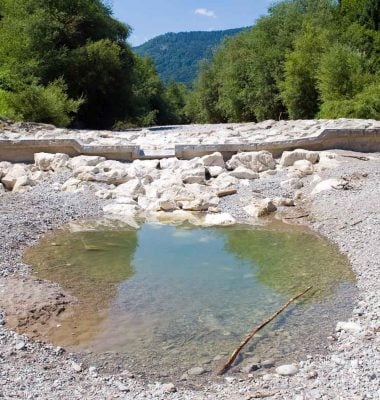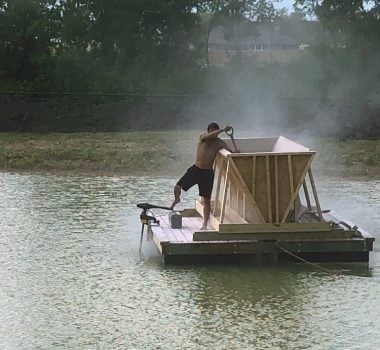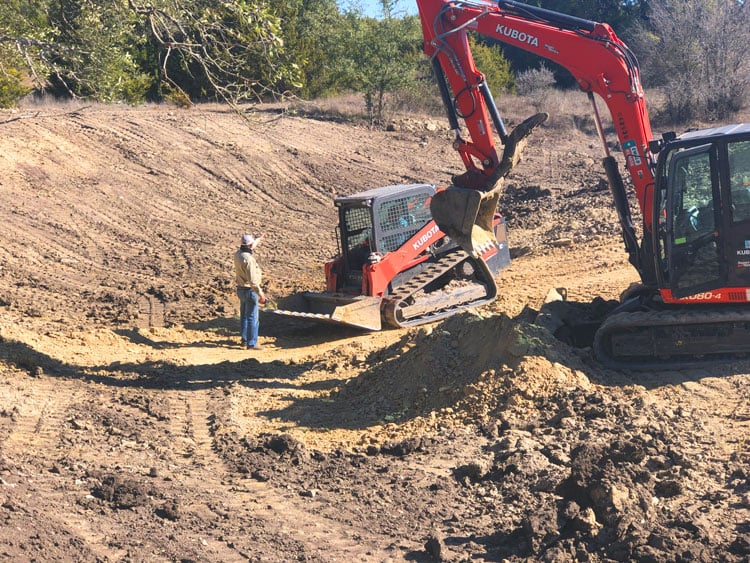Lonestar Minerals fix ponds and lakes service is designed to repair any leaks in your pond or lake without added worries. We supply equipment, materials, workforce and the expertise required to fix your leaking pond. Trust our team to stopany pond leaks using bentonite pond sealer and enjoy the results for long future years.
FIX A LEAKING POND WITH SODIUM BENTONITE
Fixing a leaking pond is no easy feat. While sometimes the leaks are obvious and easily detected, some other times they aren’t so easily detected and fixed. If you think your pond may be leaking, besides an obvious reduced level of water you can look for signs of wet patches in the areas around the pond or specific areas that are growing vegetation out of season.
A pond is an investment. If you strongly suspect you have a leaking pond in your hands, protect your investment by contacting us to help you determine the best course of action to fix the pond. The earlier you detect a leak, the better chances of a lower investment and a less invasive fix.
Trust a company that has over 50 years experience fixing ponds and lakes, all over Texas and surrounding states like Nebraska, Colorado, Louisiana and Oklahoma. Believe us when we say we have seen many different scenarios: holes dug by all sorts of rodents, leaks in the dam or embankment area, leaks around the outlet structure, ponds with little or no clay content… Our expertise is at your service.

ADVANTAGES OF USING BENTONITE TO FIX A LEAKING POND
At Lonestar Minerals we use sodium bentonite to fix ponds and lakes simply because it makes sense. Bentonite as a mineral is a low cost material, 100% natural, with a very high effectiveness for reducing water seepage and sealing any leaks.
The investment for fixing a pond with bentonite pond sealant is comparable to other sealants. Bentonite has the upper hand being very low maintenance and sensible only to erosion. In contrast to rubber liners, there is no tear risk involved, making it especially good for livestock ponds. It is absolutely inocuos for vegetation, fish, wildlife, swimming or irrigation.
Bentonite is a versatile solution that can be used in many applications. For ponds that can’t be drained or for localized leaks, granular bentonite can be used as a sealant, applied in the form of a slurry, allowing the grains to set themselves inside any gaps or crevices as the water flows through them, therefore creating a good watertight seal. For dry ponds, the bentonite clay is mixed with the soil of the pond, effectively sealing any cracks or holes at contact with water.

LONESTAR MINERALS: PROFESSIONAL “FIX A POND” SERVICE
Lonestar Minerals has paid special attention to providing an integral service that takes care of fixing a leaking pond from start to finish without adding to your worries. Leave your leaking pond in our hands and enjoy the results for many years. We source and provide any supplies or workforce required to finish the job.
We work with farmers, ranchers, homeowners, municipalities, contractors, excavators and many other clients. We can design, build, reshape and fix any type of pond or lake: retention ponds, farm ponds, fish ponds, irrigation ponds, recreational ponds, wildlife ponds, artificial lakes, among others.
Lonestar Minerals is a leading company in bentonite products and services. We mine the bentonite, mill it at our manufacturing plant and deliver it according to our client’s needs and specifications. We pay special attention to quality, having an ISO-9001 certified processing plant, which ensures you receive only the highest quality bentonite for ponds.
Leave your pond in the hands of a company committed to work with excellence and integrity, get a free quote today to fix your leaking pond.

FAQs
Do I have to empty the pond to repair it with bentonite?
We recommend applying the bentonite to a dry pond. It can be applied to a pond with water, but that introduces several more variables into the equation, and is not as effective as applying it to a dry pond and has the risk of not obtaining the desired results.
Is bentonite better than passive pond liners?
Every pond liner has it’s advantages and disadvantages and, of course, there are several schools out there. We believe that passive pond liners are a good option for garden ponds (maybe two or three thousand square feet), but when it comes to farm ponds, ranch ponds or artificial lakes, bentonite is less prone to puncturing or degradation. In our experience the initial investment is quite similar. Still, bentonite has the upper hand in the long term, with fewer maintenance costs and creating a natural pond ecosystem and not just a water retention tank.
Can I apply the bentonite by myself or do I need to hire your team to do it?
When purchasing the bentonite with us, we are pleased to guide you through the process of applying the bentonite yourself if you have the equipment and the willingness to do so. If it is not possible to do the application yourself for any reason, we are also able to take our team to your property to do the application process for you.
Where are Lonestar Minerals warehouses located?
We have three warehouse locations in Texas, in the cities of Bulverde, San Antonio, and Eagle Pass. They are open Monday through Friday from 9:00 AM to 4:00 PM. CST., and deliveries are only by appointment. We store 50 lbs. buckets, 50 lbs. paper bags, 100 lbs. paper bags, and 3,000 lbs. super sacks. We can also coordinate freight and deliver from Wyoming to the northern states to reach them within one day. We can coordinate logistics nationwide at a very competitive rate from LTL (Less-Than-Truckload) to FTL (Full-Truck-Load).
What makes Lonestar Minerals pond sealant different?
Our Bentonite Pond Sealant Mix Mesh is unique and has been developed using our 50+ years of experience in the field. We offer a select milled clay product for pond sealing that is a mix-mesh powder-granular product combining different mesh sizes, allowing the performance of this mix-mesh pond sealant to be superior to other similar products in the market.
How much bentonite is needed to seal my pond?
The most important factor to determine the amount of bentonite pond sealer required is the type of soil of your pond. Depending on it is how much bentonite pond sealant we recommend applying per square foot.
Here are some reference values that can help you estimate the required amount of bentonite to seal your pond (based on the Lonestar Minerals quality bentonite mix-mesh for ponds). Or, if you prefer, we have available a Bentonite calculator to easily approximate the amount of bentonite required for your pond.
Soil condition → Recommended range amount of bentonite pond sealer per square foot
Rock or gravel → 3.0 to 3.5 lbs/sqft
Clean Sand → 2.5 to 3.5 lbs/sqft
Silty Sand → 2.0 to 2.5 lbs/sqft
Sandy Silt 20% Clay Min → 1.5 to 2.0 lbs/sqft
Clay Soil → 1.0 to 1.5 lbs/sqft
